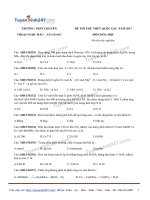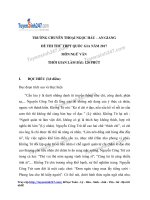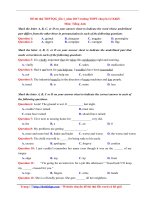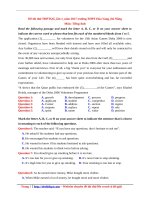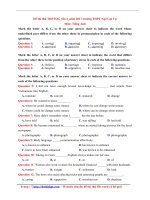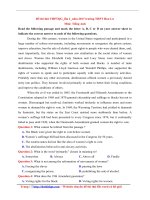- Trang chủ >>
- THPT Quốc Gia >>
- Ngoại Ngữ
de thi thu thptqgmon tieng anhlan 2nam 2017 so gddt tinh dac lac file word co loi giai
Bạn đang xem bản rút gọn của tài liệu. Xem và tải ngay bản đầy đủ của tài liệu tại đây (139.43 KB, 15 trang )
Đề thi thử THPTQG_lần 2_năm 2017 sở GD&ĐT tỉnh Đắc Lắc
Môn: Tiếng Anh
Mark the letter A, B, C or D on your answer sheet to indicate the sentences that is closest
in meaning to the given sentence in each of the following questions.
Question 1: If only I had taken that job in the bank.
A. I wish I tool that job in the bank
B. I regret not taking that job in the bank
C. I regret not take that job in the bank
D. I don’t take that job in the bank
Question 2: Apart from Bill, all the students said they would come to the party.
A. All the students said that they would come to the party with Bill
B. All the students said they would come to the party without Bill
C. Every student said they would come to Bill’s party
D. Bill was the only student who wouldn’t come to the party.
Question 3: I strongly disapproved of your behavior, However, I will help you this time.
A. Although I strongly disapproved of your behavior, but I will help you this time
B. Despite I strong disapproval of your behavior, I will help you this time
C. Because of your behavior, I will help you this time
D. Despite of my strong disapproval of your behavior, I will help you this time
Question 4: I left for a two-week holiday as soon as I finished my project
A. Right after I had returned my two-week holiday, I finished my project
B. Scarcely had I left a two-week holiday before I finished my project
C. No sooner had I finished my project than I left for a two-week holiday
D. I had hardly had a two-week holiday when I finished my project
Question 5: Friendly thuogh he may seem, he’s not to be trusted
A. He may have a lot of friends, but he’s not to be trusted
B. He’s too friendly to be trusted
C. However friendly he seems, he’s not to be trusted
D. No matter how he seems friendly, he’s not to be trusted
Mark the letter A, B, C or D on your answer sheet to indicate the most suitable response
to complete each of the following questions.
Question 6: “You really have a fashionable jacket, Mary! You look great in it” – “______”
A. Really? Thank you, Nam. You must be kidding
B. The same to you
C. Thank you, Nam. I think it is not very nice
Trang 1 – Website chuyên đề thi thử file word có lời giải
D. Thank you, Nam. I glad you like it
Question 7: Jonh “Would you like me to get a taxi?” – Mary “____”
A. Well, let’s see
B. Yes, please, if it’s no bother
C. That would be delightful. Thanks
D. Yes, I see
Read the following passage and mark the letter A, B, C or D on your answer sheet to
indicate the correct answer to each of the following questions.
Who talk more – men or women? Most people believe that women talk more.
However, linguist Deborah Tannen, who has studied the communication style of men
and women , says that this is a stereotype . According to Tannen, women are more verbal –
talk more – in private situations , where they use conversation as the “glue” to hold
relationships together. But, she says, men talk more in public situations, where they use
conversation to exchange information and gain status. Tannen points out that we can see these
differences even in children. Little girls often play with one “best friend”, their play includes
a lot of conversation. Little boys often play games in groups; their play usually involves more
doing than talking. In school, girls are often better at verbal skills, boys are often better at
mathematics.
A recent study at Emory University helps to shed light on the roots of this difference.
Researchers studied conversation between children age 3-6 and their parents. They found
evidence that parents talk very differently to their son than they do to their daughters. The
startling conclusion was that parents use more language with their girls .Specifically, when
parents talk with their daughters , they use more descriptive language and more details. There
is also far more talk about emotions, especially sadness, with daughters than with sons.
Question 8: Which sentence best expresses the main idea of the first paragraph?
A. Women talk more in private , and men talk more in public.
B. Women talk more than men.
C. Little girls and little boys have different ways of playing.
D. It’s stereotype that women talk more than men
Question 9: Which can be used as a synonym of the word emotions?
A. feelings
B. thinkings
C. worries
D. anger
Question 10: Which sentence best expresses the main idea of the second paragraph?
A. An Emory University found that parents talk more with their daughters than with sons
B. Parents do not talk much about sadness with their
Trang 2 – Website chuyên đề thi thử file word có lời giải
C. Study at Emory University can help to explain the differences between communication
styles of boys and girls
D. Researchers have studied the conversations of children and their parents.
Question 11: Which of the following statements is TRUE about the passage?
A. Parents use more language to talk with their daughters.
B. Boys don't like showing their emotions.
C. Parents use more language to talk with their daughters
D. Girls are thought to be more talkative than boys
Question 12: Which word could best replace "startling" ?
A. surprising
B. annoying
C. beginning
D. interesting
Question 13: Which of the following phrases best explains the meaning of the word
"verbal"?
A. being very talkative
B. connected with the use of spoken language
C. deriving from verbs
D. using very loud noise
Question 14: Which of the following statements can be inferred from the second paragraph?
A. A recent study found that parents talk differently to their sons and daughters.
B. Boys don't like to be with their parents as much as girls do.
C. Parents don't enjoy talking with their sons as much as with their daughters
D. Girls have more practice discussing sadness than boys do.
Question 15: The word they in line 4 refers to____
A. men
B. men and women
C. Situations
D. women
Mark the letter A, B, C or D on your answer sheet to indicate the word or phrase that is
OPPOSITE is meaning to the underlined part in each of the following questions.
Question 16: My friend tends to look on the bright side in any circumstances.
A. be smart
B. be confident
C. be pessimistic
D. be optimistic
Question 17: All children can attend without paying fees at state school.
A. hight schools
B. primary schools
C. independent schools
D. secondary schools
Mark the letter A, B, C or D on your answer sheet to indicate the word or phrase that is
CLOSEST is meaning to the underlined part in each of the following questions.
Question 18: They decided to postpone their journey till the end of the month because of
epidemic.
Trang 3 – Website chuyên đề thi thử file word có lời giải
A. put off
B. turn round
C. do with
D. carry on
Question 19: In the future many large corporations will be wiped out an millions of jobs will
be lost.
A. destroyed
B. developed
C. broadened
D. opened
Read the following passage and mark the letter A, B, C or D on your answer sheet to
indicate to the word or phrase that best fits each of the numbered blanks
Traditionally, Americans and Asians have very _____ideas about love and marriage.
Americans believe in ‘romantic’ marriage – a boy and a girl are ____ to each other, fall in
love, and decide to marry each other. Asians, on the other hand, believe in contractual
marriage – the parents of the bride and the groom decide on the marriage; and love – if it ever
develops – is supposed to follow _____, not precede it.
To show the differences, a ______was conducted among American, Chinese and Indian
students to determine their attitudes _____ love and marriage
Question 20:
Question 21:
Question 22:
Question 23:
Question 24:
A. same
A. loved
A. marriage
A. research
A. about
B. different
B. handed
B. marry
B. investigation
B. towards
C. strange
C. attracted
C. marrying
C. survey
C. of
D. old
D. married
D. married
D. discovery
D. for
Read the following passage and mark the letter A, B, C or D on your answer sheet to
indicate the correct answer to each of the following questions.
The rules of etiquette in American restaurants depend upon a number of factors the physical
location of the restaurant, e.g., rural or urban; the type of restaurant, e.g., informal or formal;
and certain standards that are more universal. In other words, some standards 5 of etiquette
vary significantly while other standards apply almost anywhere. Learning the proper etiquette
in a particular type of restaurant in a particular area may sometimes require instruction, but
more commonly it simply requires sensitivity and experience. For example, while it is
acceptable to read a magazine in a coffee shop, it is 10 inappropriate to do the same in a more
luxurious setting. And, if you are eating in a very rustic setting it may be fine to tuck your
napkin into your shirt, but if you are in a sophisticated urban restaurant this behavior would
demonstrate a lack of manners. It is safe to say, however, that in virtually every restaurant it is
unacceptable 15 to indiscriminately throw your food on the floor. The conclusion we can
most likely draw from the above is that while the types and locations of restaurants determine
etiquette appropriate to them, some rules apply to all restaurants.
Trang 4 – Website chuyên đề thi thử file word có lời giải
Question 25: With what topic is this passage primarily concerned?
A. instruction in proper etiquette
B. rules of etiquette
C. variable and universal standards of etiquetteD. the importance of good manners
Question 26: Which of the following words is most similar to the meaning of “rustic”?
A. ancient
B. Urban
C. Unsophisticated
D. agricultural
Question 27: The author uses the phrase “safe to say” in order to demonstrate that the idea is
A. somewhat innocent B. quite certain
C. very clever
D. commonly reported
Question 28: What is the author’s main purpose in this passage?
A. to describe variations in restaurant manners
B. to assist people in learning sophisticatedmanners
C. to simplify rules of restaurant etiquette
D. to compare sophisticated and rustic restaurants
Question 29: What does the word “it” refer to line 5?
A. knowing the type of restaurant
B. clear instruction
C. learning the proper etiquette
D. sensitivity
Question 30: According to the passage, which of the following is a universal rule of
etiquette?
A. eating in rustic settings
B. tucking a napkin in your shirt
C. reading a magazine at a coffee shop
D. not throwing food on the floor
Question 31: The word “manners” in line 13 could best be replaced by which of the
following?
A. Tact
B. Ceremony
C. Experience
D. Character
Mark the letter A, B, C or D on your answer sheet to indicate the underlined part that
needs correction in each of the following questions.
Question 32: Had I been interested in that subject, I would try to learn more about it.
A. in
B. try to learn
C. had
D. about
Question 33: The two children tried as hardly as they could to bring about a reconciliation
between their parents.
A. children
B. hardly
C. between
D. to bring about
Question 34: With his many theories, Albert Einstein did a great impact on physic, so much
so that he is often called the greatest physicist of all time.
A. did
B. so much so that
C. physicist
D. many
Trang 5 – Website chuyên đề thi thử file word có lời giải
Mark the letter A, B, C or D on your answer sheet to indicate the word that differs from
the rest in the position of the main stress in each of the following question
Question 35:
Question 36:
A. accompany
A. formal
B. refusal
B. cancel
C. infamous
C. install
D. necessity
D. perfect
Mark the letter A, B, C, or D on your answer sheet to indicate the correct answer to
each of the following question.
Question 37: It is very important for a firm or a company to keep ____ the changes in the
market.
A. touch with
B. track about
C. up with
D. pace of
Question 38: He asked me why _____ to the meeting
A. you didn’t come
B. I hadn’t came
C. didn’t you come
D. didn’t I come
Question 39: Will you take care _____ my little dog when I am ___ business?
A. through/ away
B. about/ at
C. of/ on
D. for/ over
Question 40: As children, we were very poor. When my father finally became rich, he told us
that he wanted to ____ all the hardship we had suffered
A. make out with
B. make up for
C. make off with
D. make over to
Question 41: Yesterday, I_____ for work late because I _____ to set my alarm
A. had been leaving/ would forget
B. had left/ forgot
C. left/ had forgot
D. was leaving/ was forgeting
Question 42: They have an apartment______ the park
A. overlooks
B. that overlooking
C. overlooked
D. overlooking
Question 43: Vitamin C _____ by human body. It gets into the blood stream quickly
A. is easily absorbing B. absorbed easily
C. is easily absorbed
D. absorbs easily
Question 44: Overseas students should make ____ the tuors and lectures.
A. up of
B. use of
C. the most of
D. out of
Question 45: Most young people nowadays believe in ____ marriage- first comes love, the
comes marriage.
A. romantic
B. unique
C. contractual
D. arranged
Question 46: In the USA the first stage of compulsory education____ as elementary
education.
A. to be generally known
B. gerally known
C. is generally known
D. generally knowing
Trang 6 – Website chuyên đề thi thử file word có lời giải
Question 47: Whenever problems____, we discuss them frankly and find out solutions
quickly.
A. confide in
B. believe in
C. agree on
D. come up
Question 48: ____ want to get a good job must have certain qualifications and experience.
A. who
B. those which
C. those
D. those who
Mark the letter A, B, C or D on your answer sheet to indicate the word whose the
underlined part differs from the other three in pronunciation in each of the following
question
Question 49:
Question 50:
A. approach
A. sliced
B. ancestor
B. released
C. apologize
C. increased
D. attention
D. raised
Trang 7 – Website chuyên đề thi thử file word có lời giải
Đáp án
1-B
11-C
21-C
31-D
41-C
2-D
12-D
22-A
32-B
42-D
3-D
13-A
23-C
33-B
43-C
4-C
14-A
24-B
34-A
44-B
5-C
15-D
25-C
35-C
45-A
6-D
16-C
2636-C
46-C
7-B
17-C
27-B
37-C
47-D
8-A
18-A
28-C
38-B
48-D
9-A
19-A
29-C
39-C
49-B
10-A
20-B
30-D
40-B
50-D
LỜI GIẢI CHI TIẾT
Question 1: Đáp án B
Dịch: Ước gì tơi có việc đó trong ngân hàng.
A. Tơi muốn tơi làm cơng việc đó trong ngân hàng
B. Tơi rất tiếc vì đã khơng làm cơng việc đó trong ngân hàng
C. Tôi rất lấy làm tiếc khi không làm công việc đó trong ngân hàng
D. Tơi khơng làm cơng việc đó trong ngân hàng
Giải thích: việc đã xảy ra: regret +Ving
Question 2: Đáp án D
Dịch: Ngoài Bill ra, tất cả học sinh nói họ đều đến bữa tiệc
A. Tất cả học sinh nói rằng họ sẽ đến bữa tiệc với Bill
B. Tất cả học sinh nói họ sẽ đến bữa tiệc ma fkhoong có Bill
C. Tất cả học sinh nói họ sẽ đến bữa tiệc của Bill
D. Bill là nguowif duy nhất không đến bữa tiệc.
Question 3: Đáp án D
Dịch: Tơi hồn tồn phải đối thái độ của bạn. Thế nhưng lần này tôi sẽ giúp bạn.
A. Mặc dù tôi đã không chấp nhận hành vi của bạn nhưng tôi sẽ giúp bạn lần này
B. Mặc dù tôi không ủng hộ mạnh mẽ hành vi của bạn, tôi sẽ giúp bạn thời gian này
C. Do hành vi của bạn, tôi sẽ giúp bạn thời gian này
D. Mặc dù tôi không chấp nhận hành vi của mình, tơi sẽ giúp bạn lần này
Question 4: Đáp án C
Dịch: Tôi sẽ đi nghỉ 2 tuần ngay sau khi hoàn thành dự án.
A. Ngay sau khi tôi đã trở lại kỳ nghỉ hai tuần của mình, tơi sẽ hồn thành dự án của tơi
B. Ít khi tôi đi một kỳ nghỉ hai tuần trước khi tơi hồn thành dự án của tơi
C. Ngay sau khi tơi đã hồn thành dự án của tơi ,tơi sẽ đi nghỉ 2 tuần
D. Tôi đã hầu như không có kỳ nghỉ hai tuần khi tơi hồn thành dự án.
Question 5: Đáp án C
Trang 8 – Website chuyên đề thi thử file word có lời giải
Dịch: Mặc dù trông anh ta rất thân thiện nhưng anh ta khơng đáng tin đâu.
A.Anh ta có thể có nhiều bạn bè, nhưng ông không đáng tin cậy
B. Anh ta quá thân thiện để tin tưởng.
C.Dù anh trông thân thiện thế nào, cũng không được tin cậy anh ta.
D. Sai cấu trúc.
Question 6: Đáp án D
Dịch: :Bạn có một chiếc jacket rất thời trang đấy, Mary”
A. Thật sao? Cảm ơn Nam. Chắc hẳn bạn đang đùa.
B. Bạn cũng thế đó
C. Cảm ơn, tơi khơng nghĩa nó đẹp đâu
D. Cảm ơn, tơi mừng vì bạn thích nó
Giải thích: đây là câu trả lời lịch sự nhất cho một lời khen.
Question 7: Đáp án B
Dịch: “Bạn có muốn tơi bắt hộ taxi không?”
A. Để tôi xem đã
B. Ừ, giuos tôi nhé nếu bạn khơng phiền
C. Thế thì thật vui, cảm ơn nhé
D. Ừm, để tôi xem.
Question 8: Đáp án A
Dịch: Câu nào tốt nhất thể hiện ý tưởng chính của đoạn đầu tiên?
A. Phụ nữ nói chuyện riêng tư hơn, và nam giới nói chuyện nhiều hơn ở ngồi.
B. Phụ nữ nói nhiều hơn đàn ơng.
C. Các bé gái và bé trai có những cách chơi khác nhau.
D. Phụ nữ nói nhiều hơn nam giới là một điều tất nhiên rồi.
Giải thích: D. Women talk more in private , and men talk more in public
dòng 3 đoạn 1: women are more verbal – talk more – in private situations
dòng 4 đoạn 1: men talk more in public situations
Question 9: Đáp án A
Giải thích: feelings = emotions: cảm xúc
Question 10: Đáp án A
Dịch: Câu nào thể hiện rõ nhất ý tưởng chính của đoạn thứ hai?
A. Một Đại học Emory phát hiện ra rằng cha mẹ nói chuyện nhiều với con gái hơn là với con
trai
B. Cha mẹ khơng nói nhiều về nỗi buồn với
Trang 9 – Website chuyên đề thi thử file word có lời giải
C. Nghiên cứu tại Đại học Emory có thể giúp giải thích sự khác biệt giữa phong cách giao
tiếp của nam và nữ
D. Các nhà nghiên cứu đã nghiên cứu các cuộc trò chuyện của trẻ em và cha mẹ của họ.
Giải thích: đoạn 2 thể hiện rất rõ ý này.
Question 11: Đáp án C
Dịch: Câu nào sau đây là đúng về đoạn văn?
A. Cha mẹ sử dụng nhiều ngôn ngữ hơn để trò chuyện với con gái.
B. Con trai khơng thích thể hiện cảm xúc của mình.
C. Cha mẹ sử dụng nhiều ngơn ngữ hơn để trị chuyện với con gái
D. Các cơ gái được cho là nói nhiều hơn nam.
Giải thích: dụa vào câu sau “The startling conclusion was that parents use more language
with their girls”
Question 12: Đáp án D
Giải thích: Interesting = Startling : thú vị.
Question 13: Đáp án A
Dịch: Cụm nào sau đây diễn tả đúng nghĩa của từ “verbal”
A. Nói rất nhiều
B. kết nối với việc sử dụng ngơn ngữ nói
C. Suy ra từ động từ
D. Sử dụng tiếng ồn rất lớn
Question 14: Đáp án A
Dịch: Những câu nào dưới đây có thể được suy ra từ đoạn thứ hai?
A. Một nghiên cứu gần đây cho thấy cha mẹ nói khác với con trai và con gái của họ.
B. Con trai khơng thích được ở cùng bố mẹ nhiều như con gái.
C. Cha mẹ không thích nói chuyện với con trai của họ nhiều như với con gái của họ
D. Các em gái có nhiều tập luyện hơn về nói về nỗi buồn so với các em trai.
Giải thích: dụa vào câu sau “They found evidence that parents talk very differently to their
son than they do to their daughters”
Question 15: Đáp án D
Dịch: Từ” they” ở đoạn 4 ám chỉ :
A. Đàn ông
B. Đan ông và phụ nữ
C. Trường hợp
D. Phụ nữ.
Trang 10 – Website chuyên đề thi thử file word có lời giải
Giải thích: dựa vào câu “According to Tannen, women are more verbal – talk more – in
private situations , where they use conversation as the “glue” to hold relationships together.”
Question 16: Đáp án C
Giải thích: look on the bright side: lạc quan
Dịch: Bạn tôi thường rất lạc quan trong mọi trường hợp.
Question 17: Đáp án C
Giải thích: State chool: trường công.
Dịch: Tất cả học sinh học trường công đều không phải trả phí.
Question 18: Đáp án A
Giải thích: postpone: trì hoãn = put off.
Dịch: Họ quyết định hoãn chuyến đi đến tận cuối tháng vì bệnh dịch.
Question 19: Đáp án A
Giải thích: be wiped out = be destroyed.
Dịch: Trong tương lai nhiều công ty sẽ bị mất hàng ngàn công việc sẽ bị mất.
Question 20: Đáp án B
Giải thích: Ở câu sau họ chỉ ra hai quan điểm khác nhau.
Question 21: Đáp án C
Giải thích: be attracted to: bị thu hút.
Ở đây khơng thể married to vì đằng sau đã có marry to each other.
Question 22: Đáp án A
Giải thích: Sau follow cần danh từ ◊ marriage.
Question 23: Đáp án C
Giải thích: cụm từ conduct a survey : Thực hiện một cuộc khảo sát.
Question 24: Đáp án B
Giải thích: attitude towards: thái độ với.
Question 25: Đáp án C
Dịch: Ý chính nào liên quan đến đoạn văn?
A. hướng dẫn phép xã giao
B. quy tắc nghi thức
C. Các tiêu chuẩn về biến đổi và phổ biến của nghi thức
D. tầm quan trọng của cách cư xử tốt
Trang 11 – Website chuyên đề thi thử file word có lời giải
Giải thích: dựa vào câu “The rules of etiquette in American restaurants depend upon a
number of factors the physical location of the restaurant, e.g., rural or urban; the type of
restaurant, e.g., informal or formal; and certain standards that are more universal”
Question 26: Đáp án C
Dịch: Từ nào sau đây tương tự nhất với ý nghĩa của "mộc mạc"?
A. cổ xưa
B. đơ thị
C. khơng tinh vi
D. nơng nghiệp
Giải thích: rustic = unsophisticated : mộc mạc, không phức tạp
Question 27: Đáp án B
Dịch: Tác giả sử dụng cụm từ "an toàn mà nói" để chỉ ra rằng ý kiến này___
A. khá trong sáng
B.khá chắc chắn
C.rất rõ ràng
D. lắm khi
Question 28: Đáp án C
Dịch: Mục đích chính của tác giả trong đoạn văn này là gì?
A. để mơ tả các thay đổi trong phong cách nhà hàng
B. để giúp người học cách cư xử tinh tế
C. để đơn giản hóa các quy tắc của nghi thức nhà hàng
D. so sánh các nhà hàng phức tạp và mộc mạc
Giải thích: Xuyên suốt đoạn văn đều nhắc về các quy tắc ứng xử, ăn uống trong nhà hàng.
Question 29: Đáp án C
Dịch: Từ "nó" đề cập ở dịng 5 là gì?
A. biết loại nhà hàng
B. hướng dẫn rõ ràng
C. tìm hiểu các nghi thức thích hợp
D. nhạy cảm
Giải thích: dựa vào câu “Learning the proper etiquette in a particular type of restaurant in a
particular area may sometimes require instruction, but more commonly it simply requires
sensitivity and experience.”
Question 30: Đáp án D
Dịch: Theo đoạn văn, điều sau đây là một quy tắc phổ quát về nghi thức?
Trang 12 – Website chuyên đề thi thử file word có lời giải
A. ăn ở các thiết lập mộc mạc
B. tucking một khăn ăn trong áo của bạn
C. đọc một tạp chí tại một quán cà phê
D. không ném đồ ăn trên sàn nhà
Giải thích: dựa vào câu “It is safe to say, however, that in virtually every restaurant it is
unacceptable 15 to indiscriminately throw your food on the floor.”
Question 31: Đáp án D
Dịch: Từ "cách cư xử" trong dịng 13 có thể được thay thế tốt nhất bằng cách nào sau đây?
A. sự khéo léo
B.lễ
C. Kinh nghiệm
D.tính cách
Giải thích: manners = tact : sự khéo léo trong cách cư xử.
Question 32: Đáp án B
Sửa: try to learn --> would have tried to learn
Dịch: Nếu tơi thích mơn đó thì tơi đã cố gắng học nó rồi.
Question 33: Đáp án B
Sửa: hardly --> hard
Dịch: Hai đứa trẻ đã rất cố gắng hết sức để giảng hòa giúp bố mẹ chúng.
Question 34: Đáp án A
Sửa: did --> had. Cụm từ: have a great impact on
Dịch: Với rất nhiều những định lý, Anh- xtanh đã có sự ảnh hưởng lớn đến nỗi mà ơng được
coi là nhà vật lý tuyệt vời nhất mọi thời đại.
Question 35: Đáp án C
A. accompany /əˈkʌmpəni/
B. refusal /rɪˈfjuːzl/
C. infamous /ˈɪnfəməs/
D. necessity /nəˈsesəti/
Question 36: Đáp án C
A.formal /ˈfɔːml/
B. cancel /ˈkænsl/
C. install /ɪnˈstɔːl/
D. perfect /ˈpɜːfɪkt/
Question 37: Đáp án C
Trang 13 – Website chuyên đề thi thử file word có lời giải
Giải thích: keep up with: bắt kịp với.
Dịch: Việc một công ty bắt kịp được với những thay đổi của thị trường là rất quan trọng
Question 38: Đáp án B
Giải thích: dựa vào lùi thì => vế này phải q khứ hồn thành.
Dịch: Anh ta hỏi tơi sao tơi khơng đến buổi họp.
Question 39: Đáp án C
Giải thích: take care of: chăm sóc ; on business: đi cơng tác
Dịch: Bạn sẽ chăm sóc cho con chó nhỏ của tơi khi tôi đi công tác chứ.
Question 40: Đáp án B
Dịch: make up for: bù đắp.
Dịch: Khi tơi cịn nhỏ chúng tơi rất nghèo. Khi bố tơi trở nên giàu có ơng nói ơng muốn bù
đắp cho tất cả những khó khăn mà chúng tôi từng phải chịu.
Question 41: Đáp án C
Giải thích: hành động đặt báo thức xảy ra trước dậy muộn.
Dịch: Ngày hơm qua tơi làm về muộn vì tơi đã quên đặt báo thức
Question 42: Đáp án D
Giải thích: overlook: nhìn ra; mệnh đề quan hệ rút gọn.
Dịch: Họ có một căn hộ nhìn ra cơng viên.
Question 43: Đáp án C
Dịch: Vitamin C thì được hấp thụ rất dễ dàng bởi cơ thể con người. Nó đi vào mạch máu rất
nhanh.
Question 44: Đáp án B
Giải thích: make use of: tận dụng
Dịch: Học sinh nước ngồi ln tận dụng các bài giảng và phụ đạo.
Question 45: Đáp án A
Dịch: Giới trẻ bây giờ tin vào tình yêu lãng man – tình u có trước rồi mới hơn nhân.
Question 46: Đáp án C
Giải thích: cấu trúc “known as”
Dịch: ở mỹ thời kỳ cơ bản băt sbuoocj đầu tiên là tiểu học.
Question 47: Đáp án D
Giải thích: problems come up: vấn đề xảy ra
Dịch: mỗi khi có vấn đề xảy ra, chúng tơi đều bàn bạc thẳng thắn và tìm ra biện pháp.
Question 48: Đáp án D
Giải thích: Those who: nhưng người mà; MĐ quan hệ rút gọn.
Trang 14 – Website chuyên đề thi thử file word có lời giải
Dịch: những người mà muốn có cơng việc tốt phải có những tiêu chuẩn nhất định và có cả
kinh nghiệm.
Question 49: Đáp án B
A. approach /əˈprəʊtʃ/
B. ancestor /ˈænsestə(r)/
C. apologize /əˈpɒlədʒaɪz/
D. attention /əˈtenʃn/
Question 50: Đáp án D
A. sliced /t/
B. released /t/
C. increased /t/
D. raised /d/
Trang 15 – Website chuyên đề thi thử file word có lời giải

